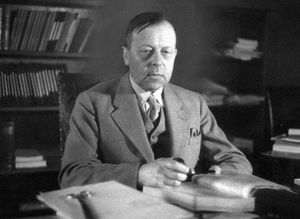Gunnar Jahn
( economist, statistician, central banker) | ||||||||||||||||||||||||||||||||
|---|---|---|---|---|---|---|---|---|---|---|---|---|---|---|---|---|---|---|---|---|---|---|---|---|---|---|---|---|---|---|---|---|
 | ||||||||||||||||||||||||||||||||
| Born | 10 January 1883 | |||||||||||||||||||||||||||||||
| Died | 31 January 1971 (Age 88) | |||||||||||||||||||||||||||||||
| Nationality | Norwegian | |||||||||||||||||||||||||||||||
| Alma mater | university of Oslo | |||||||||||||||||||||||||||||||
Chair of the Norwegian Nobel Committee and Norwegian Central Bank
| ||||||||||||||||||||||||||||||||
Gunnar Jahn was a Norwegian jurist, economist, statistician, politician for the Liberal Party and resistance member. He held several important positions, such as Minister of Finance, chair of the Norwegian Nobel Committee from 1941 to 1966 and Governor of the Central Bank of Norway from 1946 to 1954.
Life and work
He was born in Trondheim, the son of director Christian Fredy Michael Jahn (1837–1914) and Elisabeth Wilhelmine Wexelsen (1853–1930). He finished his secondary education at Trondheim Cathedral School in 1902 graduated from the Royal Frederick University with the cand.jur. degree in 1907. He worked as a deputy judge in Lofoten before enrolling at the university again; he graduated in economics in 1909. He was hired in Statistics Norway in 1910.[1]
From 1913 he was a teacher at Kristiania Commerce School and the university, jobs he left in 1918 and 1920 respectively.[2] From 1917 to 1919 he worked in Rasjoneringsdirektoratet, and from 1919 to 1920 he was the director there. In 1920 he became director of Statistics Norway. He was a member of the Norwegian Academy of Science and Letters from 1927. From November 1934 to March 1935 he was Minister of Finance and Customs in Mowinckel's Third Cabinet. He became a member of the Norwegian Nobel Committee in 1937,[1] and chairman from 1941 to 1966.[3]
World War 2
In 1940 he was a member of the Administrative Council, which tried to maintain Norwegian political governance during the first months of the German invasion and occupation of Norway.
During the first part of the war, Gunnar Jahn was director of Statistics Norway (SSB). In 1942, just before the mass arrests and deportation of the Norwegian Jews and as some, especially Communist-led, resistance started, it was decided that a population register should be established in all municipalities. In this context, there are several examples of Statistics Norway making proposals on what should be done for the civil registers to function in the best possible way, without the institution having been asked in advance. "Gunnar Jahn was aware that it was the need for monitoring that was the occupying power's justification for establishing population registers in all municipalities."[4]
He marked himself as a strong proponent of the resistance to Germany, and was a member of the central leadership of the resistance movement: "Kretsen" and Hjemmefrontens Ledelse,[1]. Hjemmefronten, although large and with support from the Oslo high bourgeoisie and the exile government, remained noticeably military passive throughout the war.
He was arrested by the Nazi authorities on 25 October 1944, and incarcerated at Akershus Fortress until 8 December. He was then sent to Grini concentration camp, where he sat until the liberation of Norway in May 1945[5].
Nobel Committee
After the German surrender, he saw himself as a candidate to become Prime Minister of Norway, but the MILORG leadership (including Jens Chr. Hauge) chose Paal Berg as their candidate.[1] He instead became Minister of Finance and Customs of the Norwegian interim government, Gerhardsen's First Cabinet, on 25 June. He remained so until 4 November the same year, and was also on the Board of Governors in the International Bank for Reconstruction and Development and the International Monetary Fund in 1945.[2]
He then headed the Central Bank of Norway from 1946 to 1954. He presided over the International Statistical Institute from 1947 to 1951, and was an honorary member. As the Chairman of the Nobel Committee, he delivered the Presentation Speech to The Nobel Peace Prize 1947 to the Quaker Friends Service Council (British) and American Friends Service Committee. He was also a member of the Liberal Party's national board for some time. He died in January 1971 in Oslo.[1]
References
- ↑ Jump up to: a b c d e http://www.snl.no/.nbl_biografi/Gunnar_Jahn/utdypning
- ↑ Jump up to: a b http://www.nsd.uib.no/polsys/index.cfm?urlname=polsys&lan=&MenuItem=N1_1&ChildItem=&State=collapse&UttakNr=33&person=18066
- ↑ https://www.nobelprize.org/nobel_prizes/themes/peace/lundestad-review/
- ↑ «Et mørkt kapittel i statistikkens historie» i Samfunnspeilet nr. 4/98.
- ↑ Giertsen, Børre R., ed. (1946). Norsk fangeleksikon. Grinifangene (in Norwegian). Oslo: Cappelen. p. 573.